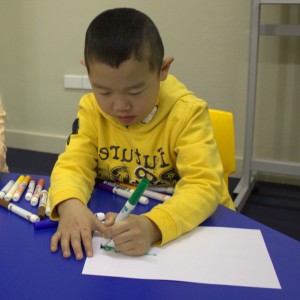 When children reach school age an important part of their language development is their ability to form "texts". These are units of language that contain a number of sentences linked together. Oral or spoken texts begin in the preschool years when children begin to link sentences together to tell about an experience (recount), tell how they did something (procedure) or tell a story (narrative). These oral texts form the basis of written texts that children produce at school, and later lead to more complex texts in the higher grades such as essays and reports. Helping children develop strong oral language skills will support children to develop good written language skills.
When children reach school age an important part of their language development is their ability to form "texts". These are units of language that contain a number of sentences linked together. Oral or spoken texts begin in the preschool years when children begin to link sentences together to tell about an experience (recount), tell how they did something (procedure) or tell a story (narrative). These oral texts form the basis of written texts that children produce at school, and later lead to more complex texts in the higher grades such as essays and reports. Helping children develop strong oral language skills will support children to develop good written language skills.
1. Recounts are often the first written texts children practice at school. My daughter called it "on-the-weekend-I" when she was in reception as that is often how early recounts are taught to beginning writers.
Recounts are a retelling an event. At school children practice both oral and written recounts. Written recounts are often a child's first experience at writing down their own ideas. Helping children to produce well structured recounts can help their oral language and literacy development. Oral recounts can be one type of text that children use during show and tell.
Why are recounts important?
Sharing information about a past event develops "decontextualised language". This is the ability to talk about something that happened in another time and place and is important for higher level language and literacy development. It also develops social skills as children practice sharing their experiences with others and learn about others perspectives and experiences.
Recounts develop the ability to structure language. Talking about the past helps develop language skills such as using verb tenses as we recount our experiences using past tense. Telling about an event is complex and requires linking sentences together by using joining words known as "conjunctions". Recounts also develop sequencing skills, the ability to put information in order; and time concepts such as first, next, last. This ability to link sentences is important for later skills such as story writing and writing essays.
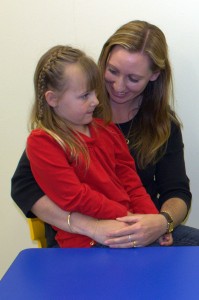 You can help your child with oral recounts by developing a habit of talking about your experiences and encouraging your child to do the same. "Tell grandma all about what we did at the beach". "Tell Dad all about the movie that we saw"
You can help your child with oral recounts by developing a habit of talking about your experiences and encouraging your child to do the same. "Tell grandma all about what we did at the beach". "Tell Dad all about the movie that we saw"
Having some visuals or props can help. Visuals can include:
- items that you collect during your activity such as shells from the beach, leaves from the park
- photos or video that you take during your event
- pictures your child has drawn of what happened
You can use a planner to help your child plan what to say or write. You can download a planner for a simple recount from Our website.
When planning a recount try to follow a structure of when + who + where + what. Such as "on the weekend" (when) Mum, Dad and I (who) went to the beach (where) for a swim (what). This structure prepares children for the structure used in story writing later on.
Once you have planned your recount, tell or write it. Try including the following:
- action words in past tense "went, swam, walked, ate"
- describing words "hot, smooth, noisy, funny"
- joining words "and, then, because"
- time concepts "first, later, in the afternoon, last of all"
Next edit and expand on your recount. Add some extra words or ideas. Fix up any mistakes with grammar or spelling.
Present your recount so you can share it with others.
To share an oral recount you could:
- video your child talking about the event
- make a slide show of pictures and record your child's voice over them
- write your child's recount down for them and ask them to draw a picture to go with it
- share it with a family member or friend on by phone or on skype
To share a written recount you could:
- write or type out the recount and illustrate it with drawings, photos or clip art
- do a slideshow or power point presentation
- share it as an email to a family member or friend
Children with communication and learning difficulties can find oral and written recounts at school difficult. To help a child with recounts at school you can try:
- developing a communication book between home and school. Parents can record information about events that the child has experienced and this can be used to help support the child in developing their recount.
- planning and rehearsing the recount. Ask your child's teacher when your child does their recount and what it is about. For example if your child writes about their weekend each Monday morning you could plan this and practice it with your child the night before. They could then take their plan and any visuals with them to school to help them with their writing.
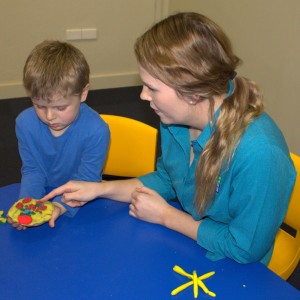 2. Procedures are a good text to practice next. They are usually longer and more complex than recounts but still based on real hands on experiences.
2. Procedures are a good text to practice next. They are usually longer and more complex than recounts but still based on real hands on experiences.
Procedures are the step by step descriptions of how to do something. Being able to retell procedures is important in developing the skills needed later in science type subjects and in understanding and writing non fiction.
Procedures help kids learn:
- sequencing skills
- how to link sentences together
- time concepts such as first, next, last
Procedures can be fun for kids to learn because they can be based around real life, hands on activities. Technology such as digital cameras and printers means it is now quicker, easier and cheaper for parents to make their own personalised resources to help their child learn these skills.
When working on procedures together:
- Start with a simple activity with three steps and make the activities longer and more complex as your child develops.
- Talk about what you are going to do and what the steps are.
- Do the activity together, talking about each step as you do it and what will come next.
- Use time concept words such as first, next, last and joining words “and then..”. “first we put butter and jam on, then next we cut the sandwich and then we eat it last”
- At the end of the activity, list each step then ask your child to tell you the steps
- If you have made some visuals (see below), help your child to use these to sequence and describe what you have done
- Talk about what you have done with someone else for extra practice “Tell Dad how you helped me make the sandwiches.”
- For school aged children record your procedure with movies, photos, a power point display or writing.
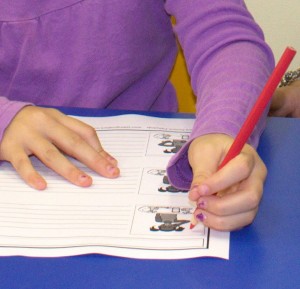 Use visuals to help your child learn to sequence the steps and describe them.
Use visuals to help your child learn to sequence the steps and describe them.
- Take some photos of your child as they do an activity, print and cut out the photos and use these for your child to put in order and retell what they have done.
- Try making short movie clips on your phone or ipad, playing them back, stopping at each step and talking about what is happening.
- Make your photos into books and write the words for each step to go with each picture
- Make your photos into a power point or slide show to look at on your computer or ipad and perhaps record a voice over with your child describing what is happening
School aged children can also:
- Use a planner to plan out the steps in your procedure before you do your activity or write your procedure.
- Write out each step onto a separate strip of paper as they think of it then put the strips in order and fill in any gaps before writing.
- Type a procedure onto the computer then use cut and paste to get the steps in order, edit and fill in any missing parts.
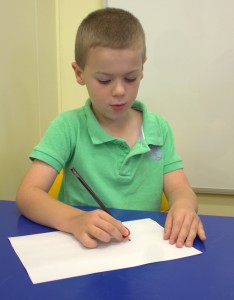 3. Stories are considered one of the most important texts for children to learn and oral stories form a valuable preparation for learning about written language.
3. Stories are considered one of the most important texts for children to learn and oral stories form a valuable preparation for learning about written language.
So why are stories so important? The ability to retell stories ties in closely with the ability to write well later on. It also relates to a child’s reading and comprehension skills. Fluent reading relies on predicting skills so the more familiar a child is with the language and structure of stories the quicker and easier a child will be able to read and understand written stories.
Listening to stories links together spoken and written language. Speech and writing have different structures and rules. Hearing stories read helps children learn these differences. Retelling stories allows children to practice forming written language structures even before they can write.
Some of the differences between written and spoken language are:
- written language uses more complete sentences
- written language provides more detail and context, because the reader cannot see what the writer is experiencing
- written language needs referencing of information such as if a person is talking or thinking “he said” or “thought the girl” is used to reference the speech or thoughts
- written language has an overall structure, which changes depending on the type of text such as story, recount, argument etc.
The structure of stories includes:
- A beginning with when, who and where information e.g. One day (when) a boy (who) went to the beach (where)
- A middle section which contains one or more problems which the characters try to solve. The story is about the actions of the characters trying to solve the problem and usually includes the feelings of the characters too.
- An ending which solves the problem and often includes how the characters are feeling when it is solved.
- Stories are usually told in past tense. Conjunctions (joining words) provide important information about how the different parts of the story tie together in time (next, suddenly, later, before that) and cause effect (because, even though, however).
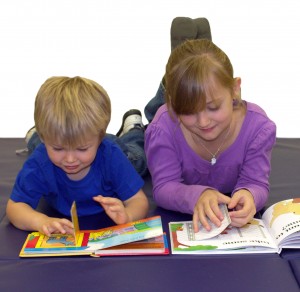 To develop your child’s ability to tell stories:
To develop your child’s ability to tell stories:
Firstly choose a picture book with clear pictures that represent the story.
Next take time to talk to your child about what the story involves:
- Who are the characters?
- What is happening?
- Why is it happening?
- How are the characters feeling?
Then tell the story to your child. You may choose to read the words or tell your own story. Try to include the story parts listed above.
Next encourage your child to tell the story from the pictures.
- Encourage them to begin with a beginning structure.
- If they use present tense repeat this back as past tense e.g. “the boy is eating the apple” becomes “the boy ate the apple”.
- Fill in parts of the story using joining words to link actions if your child does not. Use “and then” to begin and use more complex joining words (so, but because, later, suddenly) as your child progresses.
- Help them to reference direct speech if they forget. e.g.: “said the boy”
- Encourage your child to use a beginning and ending structure.
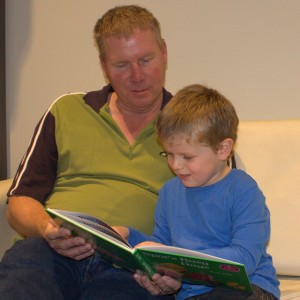 Ideas for practising storytelling:
Ideas for practising storytelling:
Make it a part of your routine to read to your child each night and get them to tell one story to you from the pictures of a favourite book.
Tell someone else. Read the story to your child then ask them to tell it to someone else, a family member, younger sibling or even a teddy
Play schools. Children love to line up dolls and teddies, sit on a chair, hold a book and be the teacher, telling the story.
Sequence stories. Scan and print some pictures from familiar stories, or buy some cheap or second fairytale books and cut up the pictures. Help your child to put the pictures in order and tell the story.
Make your own stories. Take some photos on a family outing, print and slip them into a mini photo album and help your child make up a story to go with the pictures. Share your stories with family and friends.
Be the narrator. Try making a slide show on the computer or ipad using your own photos and recording your child’s voice telling the story.
Act it out. Use dolls, toy figurines, or plastic animals to act out a familiar story. Tell the story as your child acts it out, remembering to use the story structures discussed, then your child can tell as you act it out. Try using dress ups and letting your child be the character.
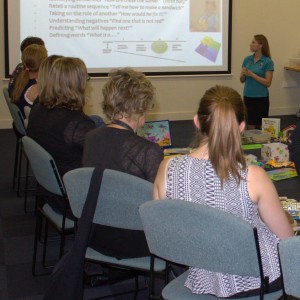 Find out more about supporting children to develop oral and written language at our workshop on 18th March. Click here for details.
Find out more about supporting children to develop oral and written language at our workshop on 18th March. Click here for details.
Looking for support for your child? If you have concerns about your child's speech or language skills the Talking Matters website has information about these skills. We provide individualised assessments and therapy for children with speech, language and learning difficulties and other disabilities. Our aim is to help parents help their child reach their potential. This information is not designed to replace professional support where this is needed rather it can be used in conjunction with professional therapy to support children's skill development.
To find out more about how the Talking Matters team can help your child click here. We provide speech pathology, occupational therapy and psychology services to children with a range of needs including language difficulties and autism spectrum disorders.
If you live in Adelaide and would like to discuss how Talking Matters can help your child call our friendly office staff on 08 (08) 8255 7137.
Jo Brenecki
Speech pathologist
Related Blog Posts
If you liked this post you may also like:
Sharing news
Talk with me - about books!
Games for Travelling
Playdough Letters



